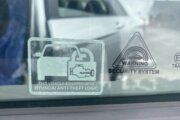Whether you’re planning to welcome a new baby into your home or you already have one crawling around and making mischief, you’ve got childproofing on the brain. But how much is necessary to keep your kid healthy and safe, and when does it become a must?
Children are unlikely to be exposed to the dangers of electrical outlets and basement steps until they start crawling around on their own, but you should be proactive about childproofing long before then. “The key is to put (childproof devices) on before they really need it,” says Hal Norman, president of Home Safe Home Childproofing Inc. in the Chicago area.
To help you get your house ready for active kids, we’re breaking down where in the house you should give particular attention and when these steps are best implemented.
[Read: How Much Does It Cost to Add a Screened-In Deck or Porch to Your House?]
Here’s how to best childproof your home:
Smoke Detectors and Water Heater
A lot of childproofing doesn’t become necessary until your child starts crawling, but there are a few things you can do before you even bring a newborn home. First up: “You want to make sure the smoke detectors are operational, and you can adjust the temperature of your water heater,” says Peter Kerin, owner of Foresight Childproofing in the Minneapolis-St. Paul area and board member for the International Association for Child Safety.
Knowing your smoke and carbon monoxide detectors are functioning will help give you peace of mind that all is well in the first days and weeks with a new baby, and by keeping your water heater set to no higher than 120 degrees Fahrenheit, you reduce the chances of scalding your baby in hot water at bath time — particularly because a baby’s skin is more sensitive than an adult’s.
Crib
The spaces your baby will spend the most time should get thorough consideration even before bringing the baby home. Especially for a newborn, any crib or bassinet should be a flat surface, with no pillows, blankets, stuffed animals or crib bumpers, as they can all be suffocation hazards even if your baby hasn’t rolled over yet. Prepare for when your baby will start moving early, and keep any cords, wires, electronics or other items out of reach. “You want to make sure there’s a 3-foot moat around the crib — a 3-foot area around the crib where there’s nothing the child can grab,” Kerin says.
Baby Gear
Even the items you buy designed for use with an infant can become dangerous if mishandled or not fully understood. “We’re a big fan of always reviewing the safety instructions,” says Colleen Driscoll, executive director of the International Association for Child Safety. Take the time to thoroughly read through the instructions and safety manual for any item you buy or receive for your baby, even something as simple as an infant bath tub.
Stairs
Keep kids from tumbling down the stairs with gates at both ends of any steps. Gates help to keep a crawling or walking baby from entering rooms without your supervision. While plastic, removable baby gates often come to mind, Norman says it’s important to install gates in a more permanent fashion at the stairs — that typically means drilling into a stud in the wall with the gate opening over the landing, as opposed to over the stairs.
Especially around stairs, be ready to revisit your childproofing as the child gets older. “That gate, which may be adequate for an 8-month-old, can be inadequate for an 18-month-old,” Kerin says.
Furniture Along the Wall
Any furniture that is taller than it is wide poses a falling hazard with a baby around — especially a curious baby that’s known to pull drawers open or try to reach a higher shelf. Eliminate the risk of your child being crushed by a bookshelf or dresser by anchoring the furniture to the wall. Many furniture companies include anchors when products are sold, but different types of hinged anchors, straps and L-shaped metal bars are easy to buy online or from home improvement stores, and will help keep furniture from tipping. This also goes for large electronics, like your TV or sound system speakers. “Anchor the furniture, anchor the TV and hide the cords so the baby can’t access any of that,” Driscoll says.
[READ: Does Your Home Have a Plumbing Problem?]
Cleaning Products
Simple household cleaning products pose a danger to young children who won’t be able to discern between a bottle of juice and a colorful bottle of bleach. While childproof latches for cabinets are a great tactic, move your cleaning products out from under your kitchen or bathroom sink and place them in a high cabinet. “Safely store those products out of sight and out of reach of children,” says Brian Sansoni, senior vice president of communications, outreach and membership for the American Cleaning Institute.
Sansoni also warns against homemade cleaning products, or at the very least taking the same care that you would with a purchased cleaning agent: “If you mix it improperly, if you mix the wrong chemicals, that can be dangerous. … If you’re doing it safely, are you labeling that? Are you making sure that colorful concoction is out of the reach of children?”
Outlets and Cords
Keep your child safe from electrical hazards in the home by securing and hiding cords and blocking access to outlets. Flat plastic outlet covers that stick into an open outlet likely first come to mind, but “the hard part with that is they’re only as good as the outlet,” Kerin says. If the outlet is old and doesn’t hold a plug well, it won’t hold the outlet cover well either.
Instead, outlet covers that attach to the plate and look like a box covering both outlets are an option, and work well to secure anything that needs to stay plugged in. Driscoll recommends going cordless when it’s possible, and when it’s not “we try to hide things behind furniture with cord covers,” she says.
Cabinets and Drawers
For all those dangerous chemicals, sharp objects and breakables you’ve cleverly hidden from sight, you also need to ensure your child won’t be able to open a cabinet, drawer or closet door. Baby safety locks come in a variety of styles and can be applied to just about any opening you’d prefer to stay closed around your child, including cabinets, toilet lids and even the fridge or oven, though some are made better than others. Both Kerin and Norman recommend magnetic locks, which can easily be disarmed so adults aren’t equally locked out of the fridge when it’s snack time. “They are still the best on the market,” Norman says.
Coffee Table
Adding bumpers and soft corners to hard furniture helps to reduce falling and bumping accidents, but sometimes it’s better to rethink a room’s layout for the sake of eliminating those falling hazards. “If there’s a coffee table in the family room, the simplest solution is to put it in the basement,” Kerin says. “Try to relocate it to a different space. If the child has more acreage to crawl around, you also remove the chances that they are going to fall on it.”
Laundry Materials
A trend in home renovations is to makeover the laundry room — a project welcomed by parents of young kids, as there’s always laundry to be done. However, with a nicer space to complete the task and plenty of laundry to do, be sure you’re securing laundry-related items and chemicals away from tiny hands and mouths. Laundry detergent pods can be particularly appealing to young children, but liquid detergent, fabric softener and dryer sheets should all also be kept out of reach and out of sight.
If you’re sprucing up your laundry room, Sansoni warns against the trend of moving any laundry products to clear jars or more attractive containers to be kept on the counter. “That can be unsafe, especially if there’s kids in the house. Those products should always, always, always be kept in their original containers,” Sansoni says. The last thing you want is for laundry detergent pods to look like candy in a candy jar.
No-Go Rooms
Some rooms are best left off-limits for kids unless you bring them in there yourself. Those spaces could be harder to childproof, like the garage or an unfinished basement, or have more items that need to be free of a kid’s touch, like a home office. For those spaces, “deny access with a high door lock,” Driscoll says. This makes it easy for adults to access, while keeping kids out. Be sure to find one that allows for use on both sides of the door, so no one gets locked in or out of a room accidentally.
[Read: How to Declutter Your Home]
Kitchen Utensils
One way to encourage safe behavior from your baby or toddler is to make sure items that can be dangerous aren’t considered a toy at any point. “Maybe you have some pots and pans, and it seems like a thing for a child to play with that’s safe, but it’s hard (for a baby) to understand that it’s a toy when you’re on the ground but it’s not when it’s on the stove,” Driscoll says. Both Driscoll and Kerin stress the importance of teaching your child that kitchen utensils are tools, not toys, and they should only be used for their intended purpose.
More from U.S. News
15 Gift Ideas to Give New Homeowners
How to Save Money While Remodeling Your Bathroom
Mother-in-Law Suites: Should You Add One to Your Home?
How to Best Childproof Your Home originally appeared on usnews.com
Update 09/30/21: This story was published at an earlier date and has been updated with new information.






